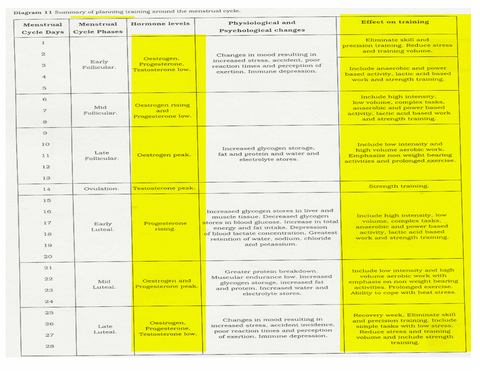The menstrual cycle is controlled by hormones. In each cycle, rising levels of the hormone oestrogen cause the ovary to develop and release an egg (ovulation). … Levels of oestrogen and progesterone fall, and the womb lining comes away and leaves the body as a period (the menstrual flow).
Here’s a diagram of how to manipulate training for best effect.

There are 4 types of PMT roughly categorised although these can overlap and people may have all, one or very severe to mild symptoms depending in each category.
Take home messages;
1. Balancing blood glucose and insulin are essential.
2. B-vitamins are essential.
3. Essential fatty acids help regulate inflammation and keep pain and swelling down.
4. Krill oil may have particular anti-depressive effects for PMT.
5. Plant based diet rocks in nearly all cases. Plus fish.
6. Do everything to lower inflammation — this has been covered in detail before.
7. Water retention can be helped with sauna and natural fluid balancers.
8. Serotonin support, follow all SAD protocols (last article)
9. Nutrients which are really helpful; magnesium, GLA, strong multi vitamin, fish oils, krill oil, 5HTP — R5 Aminos.
10. Adaptogens are really supportive too.
If you find this useful please consider using Aminoman.com for the supplemental support

Keeping a chart and grading your symptoms you will be able to track any improvements once you change your foods and nutrition to support your goals;
Grading of Symptoms
1. none.
2. mild — present but does not interfere with activities
3. moderate — present and interferes with activities but not disabling.
Severe — disabling (unable to function)
TYPE A; Blood sugar and calmness protocol (serotonin)
Anxiety, irritability, mood swings, tension
Often associated with high estrogen & low progesterone levels, occurs in 75% of cases.
May be associated with a deficiency of B vitamins especially B6 & B12, Vitamin C, E, Selenium, and Magnesium. These are all needed by the liver to break down and inactivate excess estrogens.
A plant rich diet and one which includes complex carbohydrate lignin, pectin, and other soluble fibres is recommended, as this will encourage the removal of excess estrogens. Plus a reduction in stimulants and alcohol and high GI carbs i.e. coffee, tea, and sugar.
Keep to 2 coffees OR 4 Teas each day. Herbal teas etc are fine. Green tea helps.
TYPE H; Fluid balance protocol & detox
Water retention, breast tenderness, weight gain, abdominal bloating
Often associated with normal or high estrogen level and a raised adrenal hormone aldosterone level.
Salt intake needs to be limited to a maximum of 3g daily. Increase potassium from all natural sources. A deficiency of vitamin E & Magnesium is often seen. This is a situation in which extra B6 as part of a b-complex or multi vitamin can help reduce excess aldosterone levels.
Exercise, sauna, detox and natural diuretics.
TYPE C; blood glucose balancing protocol
Food/sweet cravings, increased appetite, heart pounding, fatigue, dizziness, fainting, and tendency to headaches.
Often associated with high estrogen & low progesterone levels. In combination with excess insulin, a reactive hypoglycemic tendency is thus often seen and needs to be normalised with both dietary control and appropriate supplements.
Deficiencies most often seen are with low Magnesium, Vitamin B6, the essential fatty acids and Chromium levels.
Worse with PCOS.
Follow all information in addiction article for cravings.
TYPE D; sleep / calmness protocol
Depression, crying, forgetfulness, confusion, insomnia.
Often associated with high progesterone & low estrogen levels a high testosterone/androgen state or heavy metal toxicity may be a contributory factor.
Nutrient deficiencies in this state may include low Vitamin B6, Vitamin C or Magnesium.
Supplement Suggestions
- Krill oil + high strength fish oils
- GLA (as borage oil)
- High strength b-complex or multi vitamin
- Additional magnesium or ZMA formula e.g. R5 Aminos..
- Consult with your nutritionist on the ideal dosages
- Additional serotonin support + mood state support
DIETARY RECOMMENDATIONS:
- Try to follow a high fish and plant based diet for a period of one month to see if it makes a difference to how you feel — work on inflammation
- Cut down on high fat dairy and excess red meat intake (unless low in ferritin) and increase intake of lean white meat, fish and vegetarian protein (fermented tofu, soya yoghurts, etc.)
- Increase the oily fish (for the correct fat intake) try krill oil supplementation
- Reduce or avoid all excess stimulants, i.e. caffeine, tea, coffee (esp. with breast tenderness and moodiness), milk chocolate, sweets; keep on dark chocolate.
- Increase all vegetables (esp. green leafy ones), nuts & seeds (try sprouting), fruit, and pulses / lentils use whole grains if you need extra energy
- Drink plenty of hot water with lemon, dilute your juices I:2 parts with water; try herbal teas or dandelion coffee (especially. in PMS — H)
· Increase your enjoyable exercise routine sweating helps detox and fluid retention
A couple of charts and more detail on types of training below;



Grading of Symptoms
- none.
- mild - present but does not interfere with activities
- moderate - present and interferes with activities but not disabling.
- Severe - disabling (unable to function)






